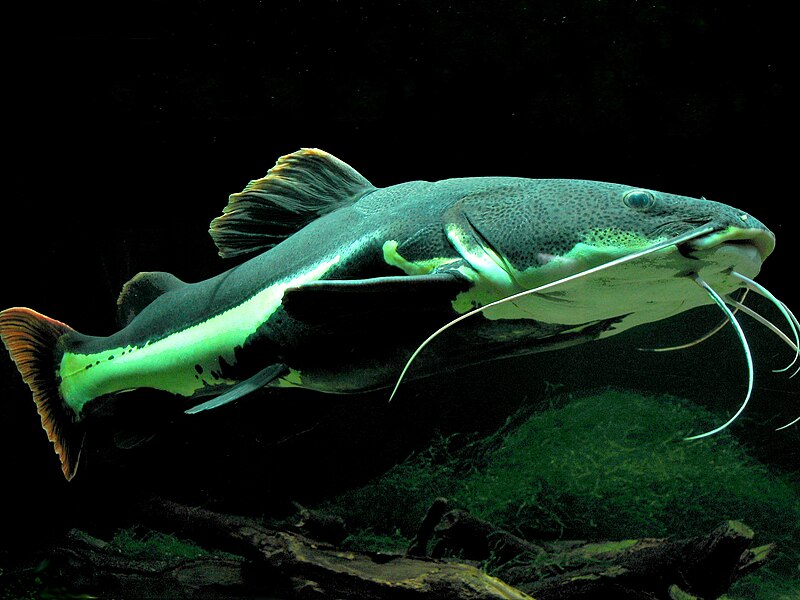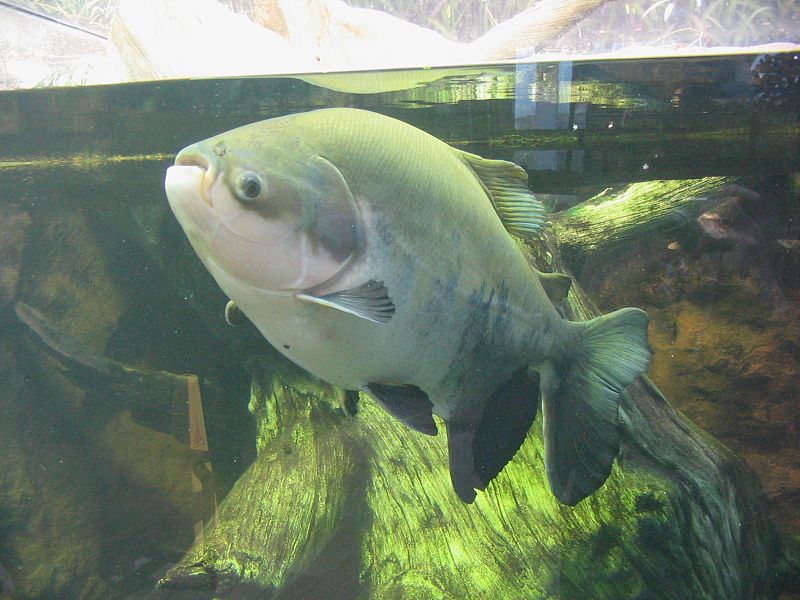Within the aquarium hobby there are many niches. There are reef geeks and coral collectors, catfish aficionados and people that think that guppies are the best thing ever. There are also those in the hobby that will give anything, and pay any price, to keep the biggest and baddest fish possible. Everyone loves an impressive fish that screams “Look at me!” But how realistic is it for the casual aquarist to keep a big fish? Well, that depends on the fish really. Let’s take a look at some of the more commonly kept aquarium giants.
 The South American Red Tail catfish (Phractocephalus hemioliopterus) is one of the most well known and most recognizable of the giant fish. Maximum published weight on this fish is a little over 90 pounds, but there are images and reports that indicate that this fish can grow much, much larger. Regardless of exact terminal size, it is obvious that this fish is going to need something special in the way of housing. If you want to keep one of these monsters, then you are looking at an aqaurium in the neighbourhood of 2000 gallons or more to keep an adult fish (that may be longer than 40 inches and weigh in at 50 pounds or more). A large indoor pond is ideal, with a big bio filter able to handle the waste that will be produced by such a large predatory catfish. Most of these fish are brought in as juveniles at about 3 inches. While they are cute and not vey intimidating when they are small, they will quickly reach a size that can be unmanageable in most commonly sold glass aquariums. If you want to keep one of these fish to adulthood be prepared to look at custom tanks or an indoor pond in your basement!
The South American Red Tail catfish (Phractocephalus hemioliopterus) is one of the most well known and most recognizable of the giant fish. Maximum published weight on this fish is a little over 90 pounds, but there are images and reports that indicate that this fish can grow much, much larger. Regardless of exact terminal size, it is obvious that this fish is going to need something special in the way of housing. If you want to keep one of these monsters, then you are looking at an aqaurium in the neighbourhood of 2000 gallons or more to keep an adult fish (that may be longer than 40 inches and weigh in at 50 pounds or more). A large indoor pond is ideal, with a big bio filter able to handle the waste that will be produced by such a large predatory catfish. Most of these fish are brought in as juveniles at about 3 inches. While they are cute and not vey intimidating when they are small, they will quickly reach a size that can be unmanageable in most commonly sold glass aquariums. If you want to keep one of these fish to adulthood be prepared to look at custom tanks or an indoor pond in your basement!
Another freshwater giant that is commonly seen and sold within the aquarium community is the Peacock Bass. Members of the genus Cichla are some of the most striking of the South American cichlids. Large and patterned with stripes, bars and eye-spots these giants can (depending on the species) reach upwards of 40 inches and can weigh over 25 pounds. These fish are sturdy and fast growing and will need aquariums that have a big footprint to keep them comfortably. An 8 foot by 4 foot aquarium that is somewhere around 30 inches deep would be acceptable, but once again, an indoor pond is a great idea for these fish as well. Smaller species can be kept in some of the larger standard size aquariums, but even those are going to require at least 300 gallons. The most commonly seen of the Peacock Bass is Cichla temensis, and that just so happens to be the biggest of the genus. Well-filtered water and stable heating are a must for these fish, so keeping them can get expensive in regards to the equipment you’ll need. These fish are highly predatory and will need a varied diet to keep them in top shape. Keeping an adult Peacock Bass well fed can also be expensive, but they are an absolutely beautiful fish when kept properly.
 The infamous Pacu is all too often offered in the trade, despite their large adult size. There are several species that are sold as Pacu, but the most commonly seen are Colossoma macropomum and Piaractus brachypomus. Unsuspecting hobbyists buy these fish as juveniles, though both species can easily surpass the 50 pound mark. I once worked at a store that had a large Piaractus brachypomus. He would often lie on his side so that you could pet him, and if you didn’t he would throw water out of the tank and onto your head. He weighed 46 pounds when he died, was at least 20 years old and measured close to 36 inches. He was kept in a custom 380 gallon aquarium that was, in retrospect, too small for him. These fish are often sold at tiny sizes and sold to people who just simply don’t know what they are getting in to. A 2 inch Pacu can easily reach unmanageable size within a year, and will have outgrown the largest of home aquariums in a few short years. These fish are strong and like to move. They have been known to break glass aquariums. If a large Pacu panics in a tank that is too small, you certainly run the risk of having glass, water, and the fish ending up on the floor. A large custom aquarium or an indoor pond, again, will be required to keep these fish right. And, just like the other giants, these fish are big and have big appetites, so having excellent filtration will be a must.
The infamous Pacu is all too often offered in the trade, despite their large adult size. There are several species that are sold as Pacu, but the most commonly seen are Colossoma macropomum and Piaractus brachypomus. Unsuspecting hobbyists buy these fish as juveniles, though both species can easily surpass the 50 pound mark. I once worked at a store that had a large Piaractus brachypomus. He would often lie on his side so that you could pet him, and if you didn’t he would throw water out of the tank and onto your head. He weighed 46 pounds when he died, was at least 20 years old and measured close to 36 inches. He was kept in a custom 380 gallon aquarium that was, in retrospect, too small for him. These fish are often sold at tiny sizes and sold to people who just simply don’t know what they are getting in to. A 2 inch Pacu can easily reach unmanageable size within a year, and will have outgrown the largest of home aquariums in a few short years. These fish are strong and like to move. They have been known to break glass aquariums. If a large Pacu panics in a tank that is too small, you certainly run the risk of having glass, water, and the fish ending up on the floor. A large custom aquarium or an indoor pond, again, will be required to keep these fish right. And, just like the other giants, these fish are big and have big appetites, so having excellent filtration will be a must.
Most of the large fish offered for sale in this hobby are impractical to keep for all but the most determined aquarist. It requires research and real estate on your part, but it is feasible to have a giant fish at home. While many of these species are kept irresponsibly, if you take the time to find out what the needs of the fish are at an adult size, then keeping a monster fish can be a very rewarding. Just remember that while many of these fish are sold at aquarium stores, some of them should not be kept unless you are willing to step up and give the fish what he needs and deserves as an adult. Purchasing a fish at a small size and thinking that you will just give him away later is never a good idea… most stores will not accept very large fish as a donation because of space requirements. So, be prepared to keep your giant fish for the long term. Do any of you guys out there have any big fish that you are keeping? We would love for you to share it with us in the comments section below!
On the next blog, we will get in to some of the marine giants that are commonly seen in the hobby.
Thanks for reading,
Craig
Pacu at Shedd Aquarium image referenced from wikipedia and originally posted by Omnitarian
South American Red-tail Catfish image referenced from wikipedia and originally posted by Monika Betley
 That Fish Blog – Aquarium Advice and Information
That Fish Blog – Aquarium Advice and Information

I think people underestimate the common pleco as well. I know I did.
I have had mine for 10 years now and he is over 1.5 feet long.
Just over two months ago I bought four, yes four black fin pacu and didn’t realize that they would grow as quick as stated in the above artical by Craig, I do want and now seems need a larger tank and have been looking for one. I really enjoy these fish and would like to add a redtail catfish at some point. Checking local louisville ky area for a good deal. Thanks for a well written artical.